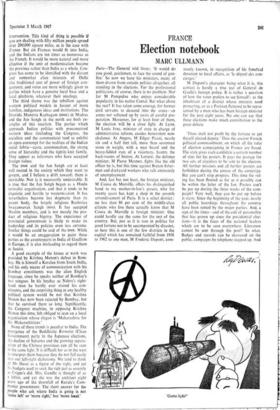India for the Indians
DICK WILSON
The loss of some eighty parliamentary seats by Mrs Indira Gandhi's Congress party has sent ripples of alarm around the capitals of the west. Things, however, are not as bad as they seem. Congress has been belaboured at the polls, but it still rules India. It retains a majority in the Lok Sabha, the lower house, and none of the opposition parties has presented itself as an all- Indian alternative government.
Not very much will change in the short term as a consequence of the election. Mrs Gandhi might even retain her premiership against Mr Morarji Desai's renewed contesting. But the election has sounded three unfamiliar themes which appear superficially to be alarming, un- healthy and detrimental to western interests. The evidence is that these themes will grow in clamour—and not only in India, but in Asia at large.
The first theme is that of youth rebelling against age. The defeat of Mr Kamaraj, the kingmaker of the Congress party, by a stripling of twenty-seven whose fame rested on his organisation of local Madras student politics, provided the most dramatic example of this. But 99 per cent of the Congress candidates were over thirty, and two-thirds were over forty- five. By contrast, the opposition parties, especi- ally those on the right, made a point of appeal- ing to the younger generation. They realised, what the Congress headquarters ignored to their cost, that twenty-five million Indian voters were casting their ballot for the first time.
This new generation, which never knew Mahatma Gandhi or the younger Nehru, and which tends to look back to British rule IN ith a faint air of disbelief, is the most vociferou, ambitious and energetic element in Indian society today. The Congress bosses whose stints of power have extended over at least two and sometimes three decades, seem fuddy-duddies in these young eyes.
The second theme is that of the provinces rebelling against the centre. It was difficult enough to govern India from Delhi when government was confined to maintaining la" and order. India has now crossed the threshold of modernity, however, and expects a complex package of change all of which depends in some degree or other on government initiative or intervention. This kind of thing is possible if you are dealing with fifty million people spread
over 200,000 square miles, as is the case with France. But six Frances would fit into India, and the Indians are ten times as numerous as the French. It would be more natural and more effective if the unit of modernisation became the province rather than India as a whole. Con- gress has come to be identified with the distant and somewhat alien interests of Delhi (the traditional seat of power of foreign con- querors), and votes are more willingly given to parties which have a genuine local base and a local platform, whatever their ideology.
The third theme was the rebellion against western political models in favour of more familiar, indigenous ideas and institutions. The Dravida Munetra Kazhagam (DMK) in Madras and the Jan Sangh in the north are both ex- amples of this reaction. The parties which approach Indian politics with preconceived western ideas (including the Congress, the socialists and the communists) tend to exhibit an open contempt for the realities of the Indian social fabric—caste, communalism, the strong sense of hierarchy and the tightly-knit family. They appear as reformers who have accepted foreign values.
The DMK and the Jan Sangh are at least well rooted in the society which they want to
govern, and I believe a drift towards them is inevitable. Nor is it necessarily undesirable. It is true that the Jan Sangh began as a Hindu
revivalist organisation, and that it tends to be jingoistic and hostile to westernisation. It has nevertheless become less dogmatic than its parent body, the largely religious Rashtriya Swayamsevak Sangh (ass). It has accepted Muslim members, and is not merely the pro- duct of religious bigotry. The experience of provincial government is likely to make its leadership and its policies even less extreme. Similar things could be said of the DMK. While it would be an exaggeration to paint these parties as the counterparts in India of Gaullism in Europe, it is also misleading to regard them as fascist.
A good example of the forces at work was provided by Krishna Menon's defeat in Bom- bay. He is himself a Keralan from South India, and his only means of communication with his Bombay constituents was the alien English language, since he speaks neither of Bombay's two tongues. In his heyday as Nehru's right- hand man he hardly ever visited his con- stituents, and the surprising thing in any healthy political system would be not that Krishna Menon has now been rejected by Bombay, but that he survived there so long. Significantly, the Congress machine, in opposing Krishna Menon this time, felt obliged to lean on a local organisation whose slogan is 'Maharashtra for the Maharashtrians.'
None of these trends is peculiar to India. The emergence of the Buddhistic Komeito (Clean Government) party in the Japanese elections, the decline of Sukarno and the growing separa- atism of the Chinese provinces can all be seen in the same light. It is difficult for us in the west to interpret them because they do not fall easily into our left-right dichotomy. We tend to think of Mr Desai as a figure of the right, and yet his budgets used to soak the rich just as severely as Cripps's did. Mrs. Gandhi is thought of as a leftist, and yet she was the architect eight years ago of the downfall of Kerala's Com- munist government. The short answer for the People who ask where India is going is not more left' or 'more right,' but 'more local'



































 Previous page
Previous page